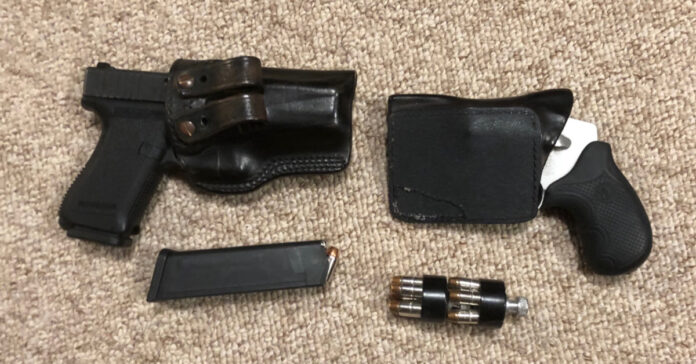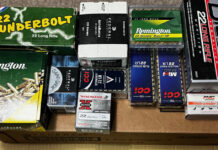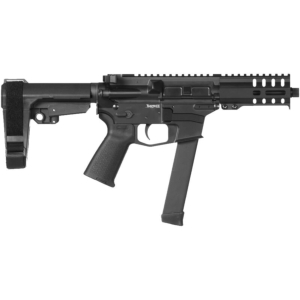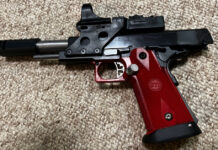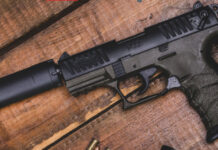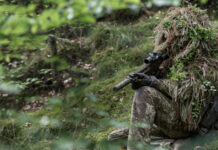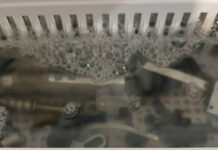Two days ago, I encouraged my readers to be armed and ready to defend themselves. Today, I’m going to share with you tips about concealed carry for those who do not carry consistently, plus I will identify the problems and annoyances I’ve run into while carrying a range of guns in various situations and attire over a period of 25 years.
Commitment and Responsibility
I believe that if you are going to carry a gun, you should do so all the time. If I am clothed, I am armed. If you decide to protect yourself and your family by carrying, then why wouldn’t you carry all the time? Do you think you only need protection at certain times and places? Don’t take your gun off at home because you feel safe; you might not be. Don’t put it on only when you are going our at night or to a “bad” part of town; bad stuff can happen anytime, anywhere.
If you’ve gone to the trouble and expense of getting a CCW permit, why leave your gun at home? It won’t do you any good there.
When I first strapped on a gun back in the 1990s, I realized that doing so meant there was an increased chance that I find myself in a situation where I would have to kill someone. It also meant there was an increased chance that I would be killed or injured in a gunfight. You have to be prepared to face both sides of that coin. Kill or be killed.
Don’t carry a gun unless you are prepared to draw it and use it. Since there will be a gun everywhere you go, you have a responsibility to see that it is used only to save innocent lives, not to take them. Don’t let anyone else take it off you, and remember that action beats reaction, so make the first shot count. Don’t let familiarity breed contempt; treat your gun with respect and take your responsibility as a member of the concealed carry community seriously.
Constant Carry
The best way to practice constant concealed carry, which is what I espouse, is to put your gun on when you get dressed and take it off when you go to bed.
Every morning, I put my every day-carry-gear in my pockets as I get dressed. Besides my keys, phone, money clip and wallet, my EDC loadout includes a one-hand-opening folding knife, a 1200 lumen tactical flashlight, a lighter, a Smith & Wesson .38 Spl revolver, two speed loaders, a Glock, and a spare magazine.
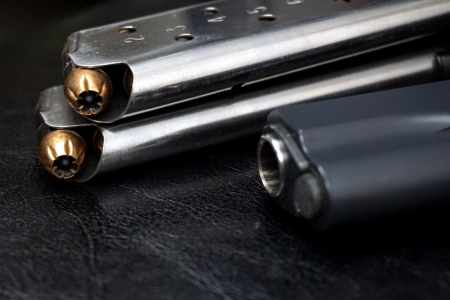
Most of the time, I carry a full size Glock 22, which holds 15+1 rounds of .40 caliber bullets, in an outside the pants holster. When I go some place where I think openly carrying a handgun would be impolite or frowned upon, I switch to a smaller Glock 23 in an inside-the-pants holster. The latter setup is much more concealable and only marginally less comfortable.
I load the magazine for my Glock 22 with two 180-grain flat-point FMJs to give me good penetration on a bear and one jacketed hollow point for expansion and a large wound channel to create more internal damage, and then I repeat the sequence, 2-1-2-1, etc. For my anti-personnel loads in my Glock 23, I use 155 grain Hydroshok or Gold Dot. My spare magazine for either gun is a 15-rounder. I have additional magazines (and boxes of ammo) in our personal vehicles.
I use 125 grain +P JHP rounds in the revolver and speedloaders. The First round is snake shot since rattlesnakes are a potential threat on our property.
The Trouble with Daily Carry
If you decide to carry, you’ll find a few things are difficult or inconvenient. For example, if you carry inside your pants, you might have to buy pants with the waist 2-inches bigger than you normally wear. You will also need a heavy duty belt, preferably made from thick, stiff leather. I have used both 1.25 and 1.5 inch belts and the extra quarter inch makes a difference, if it can fit in your belt loops.
You’ll also have to worry about cover garments, items of clothing that keep the average citizen from seeing your gun. This is easy in the winter, but harder in the summer. With a small gun and a good holster, a t-shirt can be sufficient. With a 1911 or other large-frame gun, you may need to wear an unbuttoned shirt over your t-shirt. For concealed carry, roomy clothing does a better job of hiding your pistol than tight clothing.
Using the Bathroom while Armed
The biggest challenge for many a new CCW guy is what to do with your gun while taking a dump. I usually draw the pistol and set it on the vanity. This works fine at home or in a private bathroom with a locked door. It’s not an option in most public bathrooms. If you can’t avoid taking a dump in public restrooms while wearing a belt-mounted holster, spread your legs wide enough to keep some tension on your gun belt to keep the gun secure and prevent the holster from flipping over. Don’t do something stupid like drop your gun, leave it in the restroom at Chuck E. Cheese’s, or have it fall out of the holster at an inappropriate time.
Round in the Chamber: Yes or No?
New CCW holders might also wonder whether to keep a round in the chamber and how the position of the safety (if your gun has one). Round in the chamber, safety on is the best practice here. First, you should always practice sweeping off the safety during the draw, so it should not slow you down at all. Second, an unloaded gun will not stop anyone. Yes, I know how to rack the slide one-handed, but why start the gunfight at a disadvantage? If you suddenly need your gun, you probably need it to be ready RIGHT NOW.
The only exception I make to this is when I carry in a fanny pack, which I rarely do. Drawing a weapon from my fanny pack is a slow, ponderous affair. I expect between unzipping the pack and release the Velcro that secures my pistol, there will probably be time to chamber a round.
Should you Unload your Gun Daily?
This is a personal decision, but if you have kids or non-gun folks in the house, I would unload it and secure it while it is not on my person. I do not want a gun that will go “bang” if anyone grabs.
For example, I choose to unload my gun every night prior to going to bed. I do this in my basement office. First, I remove the magazine, eject the round in the chamber, set it aside, run the slide back and forth a few times, check both the magazine well and chamber visually and with my finger, and then drop the slide, point the gun at an old Level III vest, and pull the trigger. I then insert the magazine but DO NOT chamber round. I re-holster the gun and go upstairs to go to bed. In the bedroom, I draw the weapon and place it on the bedside table.
This daily gun handling may minutely increase the chance of a unintentional discharge, but I prefer it to leaving a gun with a loaded chamber just lying around unsupervised. I also think having a pistol without the bullet in the chamber on my bedside table is safer than having it loaded while I sleep two feet away.
When I reload the gun the next morning, I rack the slide to chamber a round. Then I remove the magazine, feed the round that came out the night before into the magazine to top it off, and re-seat the magazine. Then I check to make sure the mag it seated correctly.
Hugging and Touching
It can also be a challenge to accept a hug if you are packing because there’s a good chance the other person might feel your gun, especially if you are wearing a shoulder holster. You hope they won’t say anything, but there’s a chance they will look surprised, confused, or try to say something funny.
If you can’t avoid a hug, position your body to make inadvertent contact with your weapon less likely. I find the trick is to keep your arms down and in. You want the other person’s arms outside of yours and up and away from your pistol. Between COVID and the Me Too movement, there’s not as much hugging going on in business circles, but you need to be aware of this at social events.
Guns and Your Spouse
If you have a CCW, you should encourage your spouse to get some training and their own permit. While it would be great to train as a team and to back each other up in a shooting scenario, there are far more mundane reasons your other half should have a CCW license. Let’s say you have a pistol in your car and your spouse borrows the car. Without a CCW, they are unintentionally breaking the law. If they have a CCW, there’s no crime.
No Guns Allowed
The final challenge is what to do when you show up somewhere and there’s a no guns allowed sign on the door. For example, you meet a friend or colleague for lunch but the restaurant has a no guns sign on their door. It’s your call, but I often ignore the sign and go in any way. After all, the gun is concealed, and the restaurant doesn’t have a metal detector, so how will they know? I try to sit in a booth or somewhere that my gun is between me and a wall, out of sight if my cover garment rides up.
Laws vary by state. Be aware of the penalty for violating a no-guns policy before you do. You want to make sure it’s a risk you are willing to take.
How Big a Gun Should You Carry?
You might ask, “Why doesn’t he carry a subcompact instead of a big Glock?” Because I feel you should carry as much gun as you can conceal and shoot well.
I have a thin, single-stack subcompacts, but I reserve those for times when stealth carry is required. Small guns are easier to conceal, but may be harder to draw and less accurate because of the short sight radius. Also, if you are open carrying, as I often do, gun size is a moot point. I spend most days on my own property and many of those hours outdoors. I openly carry a .40 or a .45 to protect myself and the dog from local wildlife that includes bears, coyotes. and possibly big cats that our beehives or chickens might attract.
Small guns, and smaller calibers like .380, .32, .25 and .22 have their place, but I generally relegate them to back up. Still, any gun is better than no gun. If your personal situation means all you can carry is a .25 pocket pistol, then carry it every day, everywhere.
For many years at work, I only carried but a 5-shot .38 revolver in my pocket because that is what I could conceal when wearing a polo shirt and slacks. Is that ideal? No, but it’s better than having no gun at all.
Carry Types and Positions
My advice is to try a range of concealed carry holsters and positions until you find one that works for you. That means you can draw the gun relatively quickly, it is at least well enough concealed to meet the legal requirements of concealed carry, and it is comfortable enough that you can carry it that way for fifteen to eighteen hours a day.
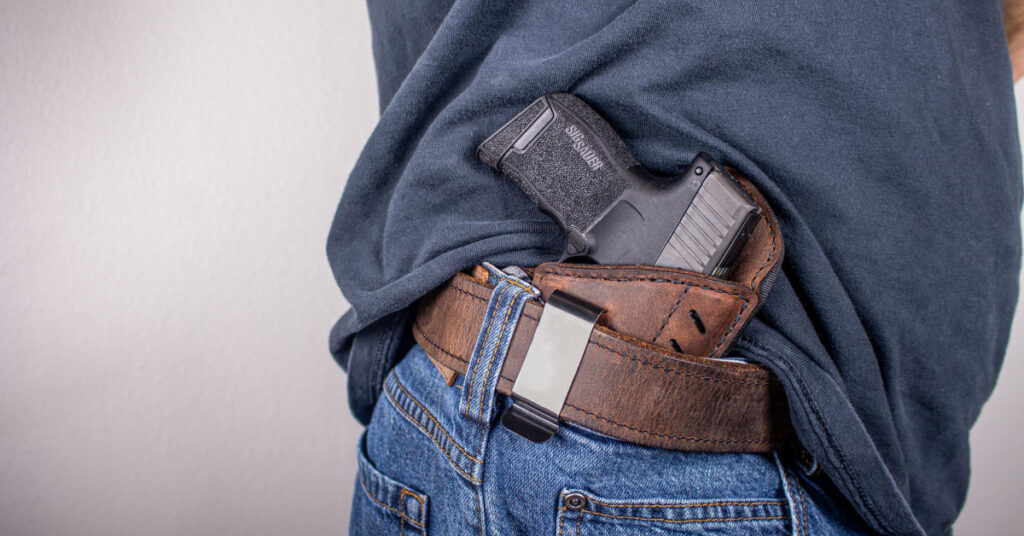
I favor strong-side carry because I consider it the fastest draw possible. I prefer to carry behind the blade of my hip, which means you cannot see my weapon when I am facing you. My belt loops and my holsters give me the ability to shift the gun a couple inches forward or back to find a comfortable position when sitting in a car, a restaurant chair, or my recliner.
Off Body Carry
Off body carry is when you carry a gun in a backpack, briefcase, purse, or other bag.
If you don’t have a belt or are wearing minimal or tight clothing, off-body carry is a valid choice. A sling pack makes a great concealed carry bag. For gals, a purse will also work. Fanny packs are OK, but half the people who see it will assume you have a gun in there. I used a fanny pack back when I was picking up my kid after school. I could leave the fanny pack in the car when I ran inside to sign her out.
One benefit of off-body carry is that you can keep other things with the gun. For example, my fanny pack held two spare magazines, a flashlight, a CAT tourniquet, and a pair of plastic zip-tie handcuffs. A downside is it can take some time to unzip your bag and access your weapon. It is also easier for someone to steal your gun if it is not on your body in your immediate control.
If you can only conceal a small caliber gun, consider carrying a larger gun off body. Use the mouse gun to create the time and space you need to draw the bigger one.
Gray Man Carry
When you decide to carry, you have to decide if you will carry discreetly or not. One example of indiscreet carry is cargo pants, photographers vest, and an NRA baseball cap. They may not see your gun, but any cop, criminal, or fellow CCW will assume you are carrying. The advantage is that a couple of bad guys planning to rob a store may hold off until you leave. The disadvantage is that they may shoot you first to remove the threat.
Discreet carry means packing a smaller gun tucked deep into the front of your pants and covered by a shirt hanging over it. For this to be effective, you need to blend in with your surroundings and avoid looking like you just walked out of the hunting store or spent two tours in Afghanistan. The advantage of discreet carry is that you have the option of if or when to make a move during an encounter.
Remember, it’s not your job to stop every petty robbery you come across. If you are not a law enforcement officer, your first duty is to save yourself and your family, not to save the money in the register. My rule is to shoot to save a life, but not to save someone else’s property. Draw your own line in the sand where you see fit.
Just remember, if you’re not carrying, your options are run, hide, or surrender and hope for the best.

